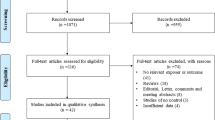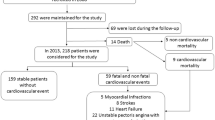Abstract
Background
Matrix metalloproteinases (MMPs) are widely expressed in atherosclerosis lesions. The disequilibrium of MMPs driving to an overexpression or a lack of its level can be influenced by genetic variations. MMP-3 and MMP-9 may be affected by specific polymorphisms like − 1612 5 A/6A and the − 1562 C/T respectively. We aim in the present study to investigate prospectively the association between the − 1612 5 A/6A MMP-3 and − 1562 C/T MMP-9 polymorphisms and clinical outcomes in patients with coronary artery disease (CAD). This study is elaborated to reveal whether one of these polymorphisms is a probable predictor of cardiovascular complications in this CAD cohort.
Methods and Results
A total of 168 patients with CAD were prospectively followed up over a period of 5 years. Genotypes for the MMP-3 (-1612 5 A/6A) and MMP-9 (-1562 C/T) polymorphisms were performed using PCR-RFLP. Their levels were measured by ELISA in Sandwich test during the follow-up period, 39 cardiovascular outcomes occurred with 21 repeat targets for revascularization, 3 patients with Myocardial infarction, 8 for heart failure, 5 for Stroke and 2 for cardiovascular mortality. The MMP-3 5 A/6A polymorphism was related to the disease on the contrary of the MMP-9 -1562 C/T. Patients carrying the 5 A allele had a higher level of MMP-3 level and those who carried the 6 A allele had lower level (p = 0.04). After applied multivariable Cox-hazard models we revealed that the 6 A allele is independently associated to the disease complication. Kaplan–Meier survival test revealed that individuals having the 6 A allele had a lower survival rate than those with the 5 A allele (p = 0.04).
Conclusion
Our study suggests the disruption of the MMP-3 level may be due to the existence of the polymorphism − 1612 residing in its promoter region. MMP-3 can be considered as a marker of diagnosis and prediction in cardiovascular events.



Similar content being viewed by others
References
Henney AM, Wakeley PR, Davies MJ, Foster K, Hembry R, Murphy G, Humphries S (1991) Localization of stromelysin gene expression in atherosclerotic plaques by in situ hybridization. Proc Natl Acad Sci U S A 88(18):8154–8158. https://doi.org/10.1073/pnas.88.18.8154
Van den Steen PE, Dubois B, Nelissen I, Rudd PM, Dwek RA, Opdenakker G (2002) Biochemistry and molecular biology of gelatinase B or matrix metalloproteinase-9 (MMP-9). Crit Rev Biochem Mol Biol 6:375–536. https://doi.org/10.1080/10409230290771546
Jefferis BJ, Whincup P, Welsh P, Wannamethee G, Rumley A, Lennon L, Thomson A, Lawlor D, Carson C, Ebrahim S, Lowe G (2010) Prospective study of matrix metalloproteinase-9 and risk of myocardial infarction and stroke in older men and women. Atherosclerosis 208(2):557–563. https://doi.org/10.1016/j.atherosclerosis.2009.08.018
Galis ZS, Johnson C, Godin D, Magid R, Shipley JM, Seniorv RM, Ivan E (2002) Targeted disruption of the matrix metalloproteinase-9 gene impairs smooth muscle cell migration and geometrical arterial remodeling. Circ Res 91:852–859. https://doi.org/10.1161/01.res.0000041036.86977.14
Wågsäter D, Zhu C, Björkegren J, Skogsberg J, Eriksson P (2011) MMP-2 and MMP-9 are prominent matrix metalloproteinases during atherosclerosis development in the Ldlr(-/-)Apob(100/100) mouse. Int J Mol Med 28:247–253. https://doi.org/10.3892/ijmm.2011.693
Hirashiki A, Yamada Y, Murase Y, Suzuki Y, Kataoka H, Morimoto Y, Tajika T, Murohara T, Yokota M (2003) Association of gene polymorphisms with coronary artery disease in low- or high-risk subjects defined by conventional risk factors. J Am Coll Cardiol 42:1429–1437. https://doi.org/10.1016/s0735-1097(03)01062-3
Ye S (2006) Influence of matrix metalloproteinase genotype on cardiovascular disease susceptibility and outcome. Cardiovasc Res 69:636–645. https://doi.org/10.1016/j.cardiores.2005.07.015
Zhang B, Ye S, Herrmann SM, Eriksson P, de Maat M, Evans A, Arveiler D, Luc G, Cambien F, Hamsten A, Watkins H, Henney M A (1999) Functional polymorphism in the regulatory region of gelatinase B gene in relation to severity of coronary atherosclerosis. Circulation 99:1788–1794. https://doi.org/10.1161/01.cir.99.14.1788
Guizani I, Zidi W, Zayani Y, Boudiche S, Hadj-Taieb S, Sanhaji H, Zaroui A, Mechmeche R, Mourali MS, Feki M, Allal-Elasmi M (2019) Matrix metalloproteinase-3 predicts clinical cardiovascular outcomes in patients with coronary artery disease: a 5 years cohort study. Mol Biol Rep 46(5):4699–4707. https://doi.org/10.1007/s11033-019-04914-4
Sambrook J, Russell DW (2006) Purification of nucleic acids by extraction with phenol:chloroform. CSH Protoc pii: pdb. prot4455. https://doi.org/10.1101/pdb.prot4455
Haberbosch W, Gardemann A (2005) Gelatinase B (C–1652 T) polymorphism in relation to ischaemic heart disease. Scand J Clin Lab Invest 65:513–522. https://doi.org/10.1080/00365510500206575
Cho HJ, Chae IH, Park KW, Ju JR, Oh S, Lee MM, Park YB (2002) Functional polymorphism in the promoter region of the gelatinase B gene in relation to coronary artery disease and restenosis after percutaneous coronary intervention. J Hum Genet 47:88–91. https://doi.org/10.1007/s100380200006
Wang J, Warzecha D, Wilcken D, Wang XL (2001) Polymorphism in the gelatinase B gene and the severity of coronary arterial stenosis. Clin Sci 101:87–92 (PMID:11410119)
Kim JS, Park HY, Kwon JH, Im EK, Choi DH, Jang YS, Cho SY (2002) The roles of stromelysin-1 and the gelatinase B gene polymorphism in stable angina. Yonsei Med J 43:473–481. https://doi.org/10.3349/ymj.2002.43.4.473
Zhi H, Wang H, Ren L, Shi Z, Peng H, Cui L, Ma G, Ye X, Feng Y, Shen C, Zhai X, Zhang C, Zen K, Liu N (2010) Functional polymorphisms of matrixmetallopeptidase-9 and risk of coronary artery disease in a Chinese population. Mol Biol Rep 37:13–20. https://doi.org/10.1007/s11033-009-9482-x
Opstad TB, Pettersen AA, Weiss TW, Akra S, Øvstebø R, Arnesen H, Seljeflot I (2012) Genetic variation, gene-expression and circulating levels of matrix metalloproteinase-9 in patients with stable coronary artery disease. Clin Chim Acta 413:113–120. https://doi.org/10.1016/j.cca.2011.09.004
Morgan AR, Zhang B, Tapper W, Collins A, Ye S (2003) Haplotypic analysis of the MMP-9 gene in relation to coronary artery disease. J Mol Med 81:321–326. https://doi.org/10.1007/s00109-003-0441-z
Abilleira S, Bevan S, Markus HS (2006) The role of genetic variants of matrix metalloproteinases in coronary and carotid atherosclerosis. J Med Genet 43:897–901. https://doi.org/10.1136/jmg.2006.040808
Liu X, Zhu R, Li Q, He Z (2016) Association of MMP-9 gene polymorphism and ischemic stroke: evidence from a case-control study to a meta-analysis. Int J Clin Exp Med 9(10):18844–18852
Beilby JP, Chapman CM, Palmer LJ, McQuillan BM, Thompson PL, Hung J (2005) Stromelysin-1 (MMP-3) gene 5A/6A promoter polymorphism is associated with blood pressure in a community population. J Hypertens 23(3):537–542. https://doi.org/10.1097/01.hjh.0000160209.48479.ae
Davies MJ (1996) Stability and instability: two faces of coronary atherosclerosis. The Paul Dudley White Lecture 1995. Circulation 94:2013–2020. https://doi.org/10.1161/01.cir.94.8.2013
Baura G (2021) Catheters, bare metal stents, and synthetic grafts. Med Device Technol 8:197–228. https://doi.org/10.1016/B978-0-12-811984-6.00008-8
Ye S, Whatling C, Watkins H, Henney A (1999) Human stromelysin gene promoter activity is modulated by transcription factor ZBP-89. FEBS Lett 450:268–272. https://doi.org/10.1016/s0014-5793(99)00509-8
Beyzade S, Zhang S, Wong YK, Day IN, Eriksson P, Ye S (2003) Influences of matrix metalloproteinase-3 gene variation on extent of coronary atherosclerosis and risk of myocardial infarction. J Am Coll Cardiol 41:2130–2137. https://doi.org/10.1016/s0735-1097(03)00482-0
Schwarz A, Haberbosch W, Tillmanns H, Gardemann A (2002) The stromelysin 1 5A/6A promoter polymorphism is a disease marker for the extent of coronary heart disease. Dis Markers 18:121–128. https://doi.org/10.1155/2002/418383
Samnegård A, Silveira A, Tornvall P, Hamsten A, Ericsson CG, Eriksson P (2006) Lower serum concentration of matrix metalloproteinase-3 in the acute stage of myocardial infarction. J Intern Med 259(5):530–536. https://doi.org/10.1111/j.1365-2796.2006.01632.x
Borghaei RC, Rawlings PL Jr, Javadi M, Woloshin J (2004) NF-kappaB binds to a polymorphic repressor element in the MMP-3 promoter. Biochem Biophys Res Commun 316:182–188. https://doi.org/10.1016/j.bbrc.2004.02.030
Udalova IA, Richardson A, Denys A, Smith C, Ackerman H, Foxwell B, Kwiatkowski D (2000) Functional consequences of a polymorphism affecting NF-kappaB p50-p50 binding to the TNF promoter region. Mol Cell Biol 20(24):9113–9119. https://doi.org/10.1128/mcb.20.24.9113-9119.2000
Rauramaa R, Väisänen SB, Luong LA, Schmidt-Trücksäss A, Penttilä IM, Bouchard C, Töyry J, Humphries SE (2000) Stromelysin-1 and interleukin-6 gene promoter polymorphisms are determinants of asymptomatic carotid artery atheroscleosis. Arterioscler Thromb Vasc Biol 20:2657–2662. https://doi.org/10.1161/01.atv.20.12.2657
Rundek T, Elkind MS, Pittman J, Boden-Albala B, Martin S, Humphries SE, Juo SH, Sacco RL (2002) Carotid intima-media thickness is associated with allelic variants of stromelysin-1, interleukin-6, and hepatic lipase genes: the Northern Manhattan Prospective Cohort Study. Stroke 33(5):1420–1423. https://doi.org/10.1161/01.str.0000015558.63492.b6
Ye S, Watts GF, Mandalia S, Humphries SE, Henney AM (1995) Preliminary report: genetic variation in the human stromelysin promoter is associated with progression of coronary atherosclerosis. Br heart J 73(3):209–215. https://doi.org/10.1136/hrt.73.3.209
Author information
Authors and Affiliations
Corresponding author
Ethics declarations
Conflict of interest
The authors declare no conflict of interests.
Financial disclosure
The study was supported by a grant from the “Ministry of High Education, Scientific Research and Technologies of Tunisia”.
Ethical approval
The survey protocol was approved by the ethics committee for human research of La Rabta Hospital and corresponds to the declaration of Helsinki 1975 ethical guidelines. All participants gave their informed consent.
Additional information
Publisher’s Note
Springer Nature remains neutral with regard to jurisdictional claims in published maps and institutional affiliations.
Electronic supplementary material
Below is the link to the electronic supplementary material.
Rights and permissions
About this article
Cite this article
Guizani, I., Zidi, W., Zayani, Y. et al. Matrix metalloproteinase 3 and 9 as genetic biomarkers for the occurrence of cardiovascular complications in coronary artery disease: a prospective cohort study. Mol Biol Rep 49, 9171–9179 (2022). https://doi.org/10.1007/s11033-022-07742-1
Received:
Accepted:
Published:
Issue Date:
DOI: https://doi.org/10.1007/s11033-022-07742-1




